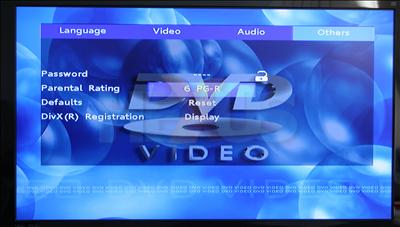Performance
Ease of use
The on-screen menu is a cinch to use. It's broken down into four sections that cover all the important video- and audio-related parameters. We also like the fact that playback of certain DVDs can be limited via a parental-control option that offers 8 age-related options. However, on our sample, even after entering a PG parental rating and applying the default password, we were still able to play the 15-rated Matrix Revolutions DVD without further prompting.
The DVD1000 also has a DivX registration submenu that, once completed, allows you to watch Video On Demand (VOD) films that can be downloaded and burned on to a disc. Of course, you'll need a separate computer for that; the DVD1000 has no network capability built-in.
Image quality
We chose three DVDs with which to evaluate the performance of the Evesham DVD1000. The Simpsons Season 1 boxset's recording is grainy and, at times, laced with artifacts. The Matrix Revolutions DVD has much higher production and transfer values and is, we feel, indicative of a well-recorded DVD. On the very high end and showcasing what DVD can still offer, is the third disc from The Lord Of The Rings: The Return Of The King Extended Edition.We used a 32in Samsung 32R41BDX LCD that was connected via an RGB-enabled SCART lead and, for high-definition, through a £10 HDMI cable. Performance via SCART was generally poor for all three DVDs. The colours were washed out and even the LOTR disc lacked the visual clarity offered by a three-year-old Sony NV705P budget player. Edges were soft and the decoration adorning Gimli's helmet, for example, was somewhat indistinct.
Yes, Gimli, it really is £70!
Moving on over to HDMI and scaling it up to 720p - which is just below the panel's native 1368x768 resolution - the quality was finer on the 2 better-recorded DVDs. The image was still somewhat soft but we observed greater general clarity and less output-related distortions in slow-moving scenes. However, we also observed some noticeable tearing when, for example, the camera panned quickly across a landscape. Colours, too, seemed sharper and cleaner, although we had to manually switch between SCART and HDMI to visually confirm the difference. HDMI was better, sure, but not to the extent that you'd think it was a completely different player, as the literature seems to suggest.
Interestingly, watching The Simpsons via HDMI proved to be a letdown. We suppose that HDMI's all-digital output/input does a better job of highlighting poor-quality recordings, so whilst the output is actually shown more faithfully, the poor recording suffers further as a result.
2-channel analogue audio quality was also reasonable when hooked-up to a Denon DM35 DAB system and Kef Cresta speakers.












